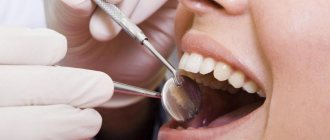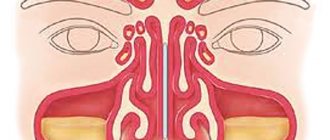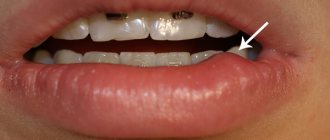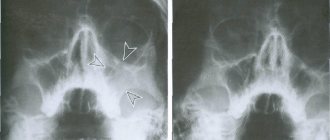Polyps in the maxillary sinus appear as a result of chronic inflammatory processes. When they grow , they interfere with breathing, cause chronic runny nose and headaches . Without diagnosis, they are poorly differentiated from other otolaryngological diseases. As a rule, treatment in a clinic according to a unified protocol does not bring results.
Our Center has been specializing in providing care to patients with pathologies of the maxillary sinuses for more than 20 years. The ENT department is equipped with modern diagnostic and functional equipment. Surgical treatment is performed by maxillofacial surgeons with ENT training.
Causes
Polyps of the maxillary sinuses are the most frequently detected formations. These are benign neoplasms of the mucous membrane in the form of processes on thin stalks or a wide base. They grow from infected tissues against the background of inflammatory processes, and are combined with the sinus mucosa by connecting elements.
Polyps in the maxillary sinus (nasal polyps)
Main causes:
- frequent infectious diseases without treatment
- chronic inflammation of the maxillary sinus
- hereditary metabolic disorder, immune system malfunction
- sinus damage, presence of foreign bodies after dental treatment
- inflammation of the tooth root at the border with the sinus
- predisposition to allergies
How is a polyp formed?
Sometimes, when examining the oral cavity, parents notice a small lump on the gum. A soft-touch bump protrudes from the base of the tooth. Such a polyp is the result of a malfunction in the process of cell division, which is a type of benign tumor. However, doctors warn that it cannot be removed independently and it is necessary to monitor the dynamics of growth.
The factors that cause a polyp to appear on a child’s gum are the following:
- chronic inflammatory processes of soft tissues (stomatitis);
- advanced cysts in the roots of baby teeth;
- gum injuries due to improper growth of fangs;
- abnormalities in the development of the baby's jaw;
- hereditary factors;
- damage to the mucous membrane by sharp edges of toys, rubbing with a pacifier or constantly holding a finger in the mouth.
Polyps on the gums or cheek begin to form during the period of active tooth growth. Almost always, the dentist prescribes an additional consultation with an orthodontist: it is believed that in 90% of all diagnosed cases, the appearance of a neoplasm is associated with bite defects. When examined, similar bumps are sometimes found on the larynx, the inner surface of the cheeks, or on the side of the tongue.
Gum polyps are classified as benign, but only growths up to 1–1.5 cm are considered safe. Despite the absence of pain, they greatly interfere with the child’s chewing and drinking. These babies may have speech defects, problems with pronunciation, and abnormal growth of soft tissue around the tooth. This bump can be easily damaged with a toothbrush, fingers or toy.
This is fraught with serious consequences for the health of the baby:
- due to the humid environment, the wound on the polyp does not heal well, it hurts and bothers;
- In case of injury, infection often develops due to the ingress of bacteria from saliva;
- A purulent focus appears inside the gums, and the rudiments of the molars are damaged.
The most dangerous complication is the risk of the polyp degenerating into a malignant tumor. You should immediately seek advice if the growth of the tumor exceeds 1–2 cm, bleeding or pain begins.
Why are polyps of the maxillary sinuses dangerous?
The insidiousness of the disease is that small polyps do not cause any inconvenience. They grow slowly, without arousing suspicion for years. In our practice, there are situations when they are discovered by chance on a computer tomogram during preparation for treatment, extraction or implantation of teeth. And this is a great success for the patient; timely treatment can be undertaken at the initial stage without radical methods.
Otherwise, the polyps gradually grow, causing inconvenience to the point of blocking breathing . A worried patient runs from one ENT doctor to another. But the hope for a high-quality, timely examination in the clinic is weak; an appointment for a computed tomography scan of the sinuses can be waited for months. And standard drug treatment prescribed without the necessary diagnostics does not help. It is good when a doctor refers a patient to a specialized institution, even at the expense of his own reputation.
Initially, polyps are benign formations, but they are prone to degeneration into malignant ones . Sometimes there is a decrease in size, but these are rare cases. Therefore, when they are detected, you need to keep the situation under control. The best solution to the problem is removal of polyps to eliminate oncological problems.
Prevention
In order for polyposis to become a thing of the past, the patient is recommended to follow simple rules:
- to refuse from bad habits;
- wear a mask when working in production with hazardous substances;
- take antihistamines ;
- lead a healthy lifestyle , watch your diet.
Also, to prevent re-inflammation of the mucous membrane, it is necessary to begin treatment at the first signs of infection, without waiting for the situation to worsen.
Despite the fact that a polyp in the oral cavity most often turns out to be a benign tumor, the symptoms of which manifest themselves to a lesser extent, the treatment of polyposis should be trusted only to an experienced specialist. It is believed that if all rehabilitation rules are followed, the risk of complications due to surgery is minimized.
Symptoms
- congestion in one or both nostrils
- feeling of constriction in the nose and throat
- lack of smell perception
- pain in the facial area
- often pain and pressure are projected onto the orbit, ear canal
- runny nose with copious mucus, frequent sneezing
If polyps of the maxillary sinuses are not removed in a timely manner, the neoplasms slowly grow, causing:
- hearing loss
- voice change
- conjunctivitis
- nosebleeds
- chronic headaches
- softening of surrounding bone tissue
- deformation of adjacent anatomical structures
- infection of the teeth at the border with the sinuses
Polyps are dangerous due to the possibility of tumors blocking the respiratory tract, even leading to death from suffocation
Why you should entrust treatment to the ENT department of dentistry
70% of patients who turned to us for help were previously treated in city clinics with many drug courses and traumatic operations in the form of sinus punctures. But, unfortunately, such methods are not able to get rid of polyps. A tumor in the paranasal sinuses can only be eliminated through surgery.
ENT dentistry is a comprehensive approach to the treatment of tumors in the maxillary sinuses. It combines two areas - otolaryngology and dentistry, allowing you to combine options for dental and ENT treatment .
Intervention in the maxillary sinuses requires highly qualified and trained physicians. Only a maxillofacial surgeon with ENT training can cope with such a task without complications . In addition, special high-tech equipment is required.
Diagnosis of polyps in the maxillary sinuses
During the examination, the main thing is to carry out a differentiated diagnosis to exclude other ENT diseases accompanied by similar symptoms
Upon visual examination, an increase in regional lymph nodes and swelling of the tissues in the area of the maxillary sinuses are observed.
X-ray examination in our Center is performed
on a computed tomograph in ENT mode .
Allows you to assess in detail the condition of the paranasal sinuses, determine the location and size of polyps. In difficult or controversial situations, the following may additionally be required:
- Videoendoscopy for examination of the nasopharynx and nasal cavity
- MRI to detect purulent fluid in the nasal appendages
- Bacteriological culture
Diagnostic features
Many types of growths in the mouth are very similar in appearance to each other. Therefore, it is necessary to correctly diagnose and exclude fibroma, papillomatosis, non-dangerous wen and possible oncology.
Before starting treatment, the child must undergo this examination:
- Ultrasound, which shows the degree of polyp growth in periodontal tissue;
- palpation of lymph nodes;
- X-ray of teeth;
- biopsy of the growth.
If a specialist has doubts about the quality and type of tumor, parents should insist on studying it after removal. This will also help identify the cause of the disease and prevent its recurrence.
Operation stages
Complex treatment is carried out in 1 day, we strive to combine all activities in one visit
- Preparation The operation is performed only after professional hygiene and sanitation of the oral cavity, and re-treatment of compromised dental roots. Sterility ensures there is no risk of infection.
- Removal Surgery according to the selected protocol for accessing the sinus with putting the patient to sleep with the simultaneous administration of an analgesic. Performed in a sterile operating room.
- Control X-ray examination CT after surgery is mandatory - to assess the quality of the operation performed and the condition of the maxillary sinus.
If a tooth with an inflamed root was removed, which provoked the growth of a polyp, after the operation the orthopedist will install a temporary orthopedic structure. You will never leave our Center without teeth.
On days 10-14, the sutures are removed and a control CT scan is performed. The patient is invited for a preventive examination and a convenient date for the visit is agreed upon.
How is recovery going?
Rest assured that we will not keep you at the Center unnecessarily
No hospitalization
Even in advanced cases with complex localization of polyps, the operation takes no more than 2-4 hours. Waking up after medicated sleep is not accompanied by deterioration of the condition and pain. The use of low-traumatic treatment protocols and the accumulated experience of doctors allow us to perform the operation as carefully as possible in relation to you. Hospitalization with an overnight stay at the clinic is not required .
For elderly patients with chronic cardiovascular diseases, a postoperative recovery service is provided in a day hospital for several hours under the supervision of an anesthesiologist. In any case, you will spend the night at home, in a familiar environment.
Inpatient recovery is necessary if general anesthesia was used, which often leads to complications, weakness and exacerbation of chronic pathologies. If a patient is offered a hospital stay for several days, this means that the clinic does not have modern equipment and qualified surgeons, or they are “squeezing” money out of you.
Branded rehabilitation on the day of treatment
The author's accelerated rehabilitation program ensures complete elimination of unpleasant consequences in the form of swelling, hematomas, muscle spasms, and pain.
Medicines to take home
After the operation, you will receive a free set of necessary medications to avoid purchasing counterfeit products. You don't have to run around pharmacies looking for the right medication in your postoperative condition.
The package with medications contains instructions with recommendations in the postoperative period. Please follow them to avoid complications.
Reasons for the formation of polyps in the mouth
In addition to localization on the gums, polyps often appear on the child’s cheek, under the tongue or on its side. They are formed from the mucosal epithelium. Such bumps often appear after the age of 7, when the baby teeth change to molars. This occurs due to constant biting of the same area.
Other reasons are:
- a sharp surge in hormones during puberty;
- malocclusion;
- too narrowed or sparse dentition;
- frequent stomatitis, gum inflammation;
- the child’s habit of sucking a pacifier after the first year of life, biting nails, hard toys.
In some cases, polyps on a child's tongue or mouth are a hereditary problem. At the genetic level, the body is prone to the formation of growths on the mucous membranes. Typically, in such children, lumps can be found on the labia and some internal organs (in the intestines, esophagus).










